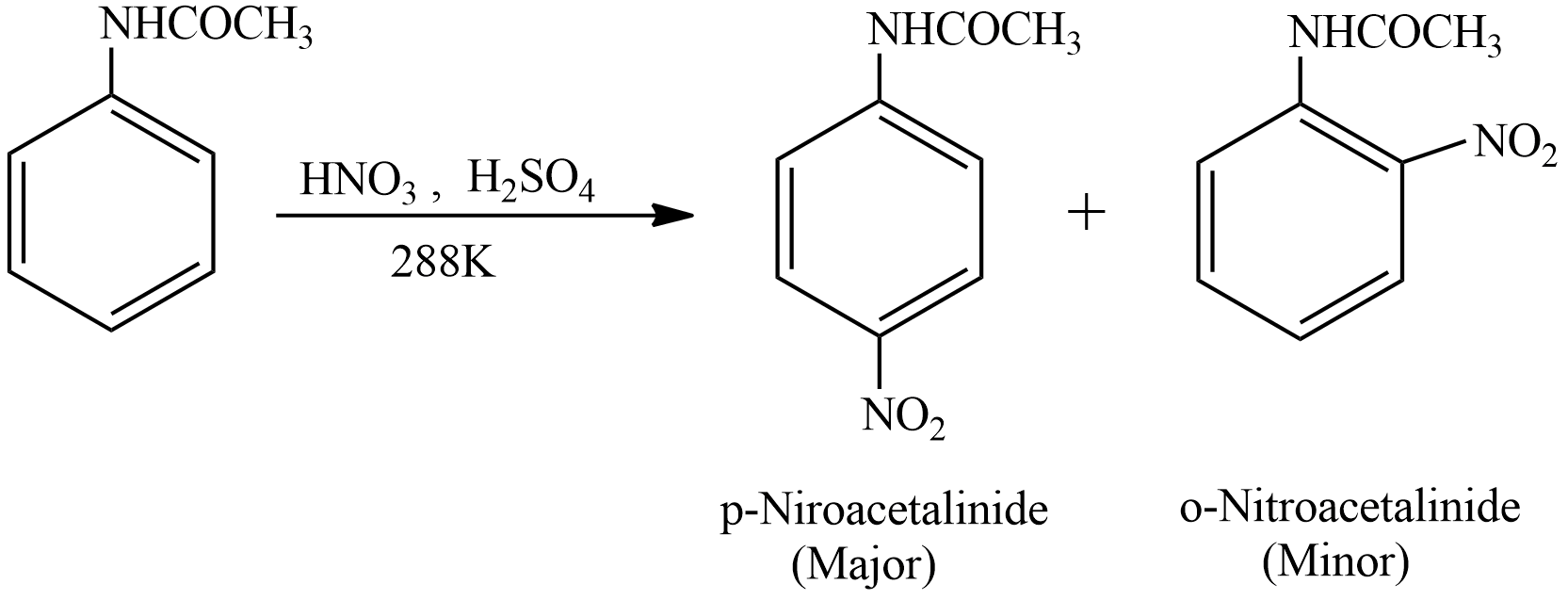
In preparation of p-nitroacetanilide another mirror product is formed. What is the compound and how can this be separated from p-nitroacetanilide?
Answer
494.4k+ views
Hint: The p-nitroacetanilide is an organic compound. Its preparation is carried out through the process of Nitration. It is also called the \[4 - nitroace\tan ilide\]. In this reaction a side product is formed also known as mirror product.
Complete answer:
Let’s see the reaction involved in the preparation of the p-nitroacetanilide

This is an electrophilic substitution reaction. Acetanilide undergoes a Nitration process in presence of Nitric and Sulphuric acid at a temperature of \[288K\]. Mixture of Nitric acid and sulphuric acid is known as Nitrating Mixture. The products formed are p-nitroacetanilide and o-nitroacetanilide. The nitro group will be attached to the para position because \[NHCOC{H_3}\] is an electron releasing group. The product para product is major product (more quantity) and ortho product is minor product (less quantity).
The minor product that is o-nitroacetanilide is separated from the p-nitroacetanilide by dissolving the solution of both products in Ethanol. o-nitroacetanilide is more soluble in alcohol as compared to the p-nitroacetanilide. During Crystallization process the o-nitroacetanilide remains in the solution as it is soluble in alcohol and p-nitroacetanilide crystallises. Then crystals of the p-nitroacetanilide are easily filtered with the help of a filter paper from the solution. The crystals of the p-nitroacetanilide are colourless.
Note:
Nitro anilines can be prepared from the product formed in this reaction as direct nitration of aniline is not possible because amino groups are oxidised when treated with nitrating mixture. For preparing nitroaniline acetanilide is subjected to nitration to form p-nitroacetanilide. Then p-acetanilide is subjected to hydrolysis to obtain p-nitroaniline.
Complete answer:
Let’s see the reaction involved in the preparation of the p-nitroacetanilide

This is an electrophilic substitution reaction. Acetanilide undergoes a Nitration process in presence of Nitric and Sulphuric acid at a temperature of \[288K\]. Mixture of Nitric acid and sulphuric acid is known as Nitrating Mixture. The products formed are p-nitroacetanilide and o-nitroacetanilide. The nitro group will be attached to the para position because \[NHCOC{H_3}\] is an electron releasing group. The product para product is major product (more quantity) and ortho product is minor product (less quantity).
The minor product that is o-nitroacetanilide is separated from the p-nitroacetanilide by dissolving the solution of both products in Ethanol. o-nitroacetanilide is more soluble in alcohol as compared to the p-nitroacetanilide. During Crystallization process the o-nitroacetanilide remains in the solution as it is soluble in alcohol and p-nitroacetanilide crystallises. Then crystals of the p-nitroacetanilide are easily filtered with the help of a filter paper from the solution. The crystals of the p-nitroacetanilide are colourless.
Note:
Nitro anilines can be prepared from the product formed in this reaction as direct nitration of aniline is not possible because amino groups are oxidised when treated with nitrating mixture. For preparing nitroaniline acetanilide is subjected to nitration to form p-nitroacetanilide. Then p-acetanilide is subjected to hydrolysis to obtain p-nitroaniline.
Recently Updated Pages
The number of solutions in x in 02pi for which sqrt class 12 maths CBSE

Write any two methods of preparation of phenol Give class 12 chemistry CBSE

Differentiate between action potential and resting class 12 biology CBSE

Two plane mirrors arranged at right angles to each class 12 physics CBSE

Which of the following molecules is are chiral A I class 12 chemistry CBSE

Name different types of neurons and give one function class 12 biology CBSE

Trending doubts
Which are the Top 10 Largest Countries of the World?

What are the major means of transport Explain each class 12 social science CBSE

Draw a labelled sketch of the human eye class 12 physics CBSE

Differentiate between insitu conservation and exsitu class 12 biology CBSE

The computer jargonwwww stands for Aworld wide web class 12 physics CBSE

State the principle of an ac generator and explain class 12 physics CBSE




